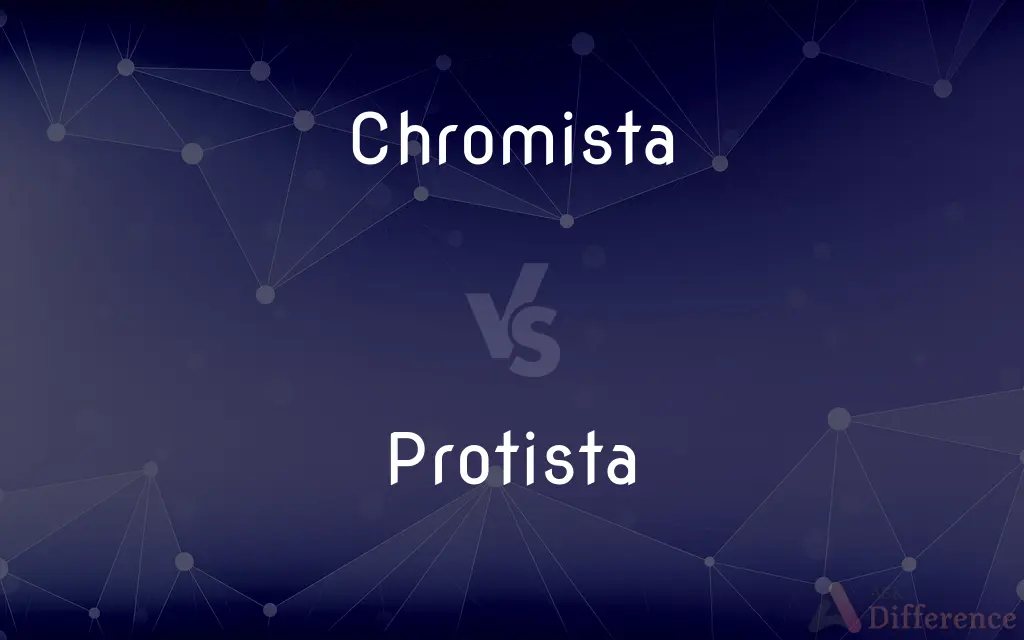Chromista vs. Protista — What's the Difference?
By Tayyaba Rehman — Published on December 19, 2023
Chromista are primarily photosynthetic organisms, including brown algae, while Protista is a diverse group of eukaryotic microorganisms, not fitting in plant, animal, or fungal kingdoms.

Difference Between Chromista and Protista
Table of Contents
ADVERTISEMENT
Key Differences
Chromista and Protista represent classifications of the biological world that have caused debate among taxonomists. Chromista primarily comprises photosynthetic organisms, most notably the brown algae, diatoms, and water molds. In contrast, Protista encapsulates a broader group of eukaryotic microorganisms.
Historically, many organisms within Chromista were categorized under Protista due to their unicellular nature or simple multicellular structures. However, as research progressed, the distinctiveness of chromistan organisms' cell structures, particularly their chloroplasts, merited a separate kingdom.
The kingdom Protista serves as a sort of "catch-all" category. It houses eukaryotic organisms that don't fit within the conventional plant, animal, or fungal kingdoms. Chromista, on the other hand, focuses more on certain algae and other photosynthetic beings, separating them from the broader protistan group.
Both Chromista and Protista play crucial roles in ecological systems. Chromistans, with their photosynthetic abilities, contribute to aquatic food chains and produce significant oxygen. Protists, with their diversity, range from free-living organisms to parasites, affecting various ecosystems and even human health.
While taxonomic divisions may evolve, the current distinction between Chromista and Protista offers clearer insights into the evolution and relationships among these diverse sets of organisms.
ADVERTISEMENT
Comparison Chart
Definition
Kingdom primarily of photosynthetic organisms.
Diverse group of eukaryotic microorganisms.
Examples
Brown algae, diatoms, water molds.
Amoeba, paramecium, slime molds.
Taxonomic Placement
Classified as a separate kingdom.
Broad "catch-all" kingdom for eukaryotes not in plant, animal, or fungal kingdoms.
Cellular Organization
Often unicellular, some simple multicellular.
Mostly unicellular, with varying structures.
Role in Ecosystem
Contribute to aquatic food chains and oxygen production.
Range from free-living organisms to parasites; some are pathogenic.
Compare with Definitions
Chromista
Includes diatoms and water molds.
Diatoms, under the Chromista kingdom, play a crucial role in oxygen production.
Protista
Diverse group of eukaryotic microorganisms.
Protista includes a vast array of different unicellular organisms.
Chromista
Distinct from other kingdoms due to specific chloroplast structures.
The unique chloroplasts of Chromista set them apart from other photosynthetic organisms.
Protista
Do not fit in plant, animal, or fungal kingdoms.
The amoeba, a member of Protista, is neither plant, animal, nor fungus.
Chromista
Kingdom of primarily photosynthetic organisms.
The brown algae are a prominent member of Chromista.
Protista
Includes both autotrophic and heterotrophic organisms.
While some Protista can photosynthesize, others rely on consuming organic material.
Chromista
Previously classified under Protista.
Some Chromista members were once considered protists due to their simple structures.
Protista
Some are free-living while others are parasitic.
Malaria is caused by Plasmodium, a parasitic member of Protista.
Chromista
Found mostly in aquatic environments.
Many members of Chromista thrive in marine and freshwater habitats.
Protista
Found in various environments from soil to water.
Protista can adapt to diverse habitats, from pond water to damp soil.
Chromista
(rare) chromist
Protista
Plural of protiston
Protista
A provisional group in which are placed a number of low microscopic organisms of doubtful nature. Some are probably plants, others animals.
Protista
Eukaryotic one-celled living organisms distinct from multicellular plants and animals: protozoa, slime molds, and eukaryotic algae
Common Curiosities
Are all Protista single-celled?
Most members of Protista are unicellular, but there are exceptions with simple multicellular structures.
Can Protista cause diseases?
Yes, certain Protista, like Plasmodium, can cause diseases such as malaria.
What is the primary characteristic of Chromista?
Chromista primarily consists of photosynthetic organisms, including brown algae and diatoms.
What is the fundamental definition of "Chromista"?
"Chromista" refers to a kingdom of eukaryotic organisms, often aquatic, that includes algae and protozoa with chlorophyll c.
Why were Chromista separated from Protista?
Chromista were distinguished from Protista due to unique cellular structures, especially their chloroplasts.
Are all Chromista found in water?
While many Chromista thrive in aquatic environments, some can exist in damp terrestrial locations.
Are Chromista primarily aquatic in nature?
Yes, Chromista primarily reside in aquatic environments, including both freshwater and marine ecosystems.
Can Protista organisms be parasitic?
Yes, some Protista, like certain protozoans, can be parasitic and live inside host organisms.
What does "Protista" refer to in biological terms?
"Protista" encompasses a diverse kingdom of simple eukaryotic organisms, which can be either single-celled or multicellular.
Do Protista have a role in the food chain?
Absolutely! Many Protista serve as primary producers or as prey for larger organisms.
Does Chromista include organisms that engage in photosynthesis?
Yes, many Chromista, such as certain algae, possess chlorophyll and engage in photosynthesis.
What color is typically associated with Chromista organisms?
Chromista are often associated with yellow-green, brown, or golden coloration due to their pigments.
Is the use of the term "Protista" in taxonomy still prevalent?
The use of "Protista" has declined and is considered somewhat outdated, as the group is highly diverse and not monophyletic.
What habitats are Protista commonly found in?
Protista can inhabit various environments, including water bodies, soil, and inside other organisms.
How is the kingdom Chromista classified in scientific taxonomy?
Chromista's classification has experienced various changes but is generally recognized as a distinct eukaryotic kingdom.
Share Your Discovery

Previous Comparison
Primary Alcohol vs. Secondary Alcohol
Next Comparison
Schwann Cell vs. OligodendrocyteAuthor Spotlight
Written by
Tayyaba RehmanTayyaba Rehman is a distinguished writer, currently serving as a primary contributor to askdifference.com. As a researcher in semantics and etymology, Tayyaba's passion for the complexity of languages and their distinctions has found a perfect home on the platform. Tayyaba delves into the intricacies of language, distinguishing between commonly confused words and phrases, thereby providing clarity for readers worldwide.













































